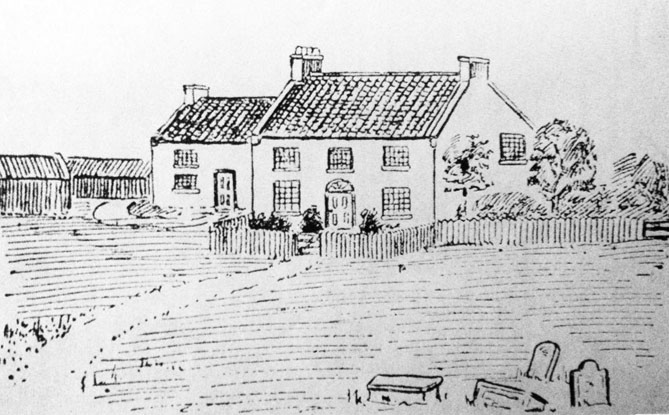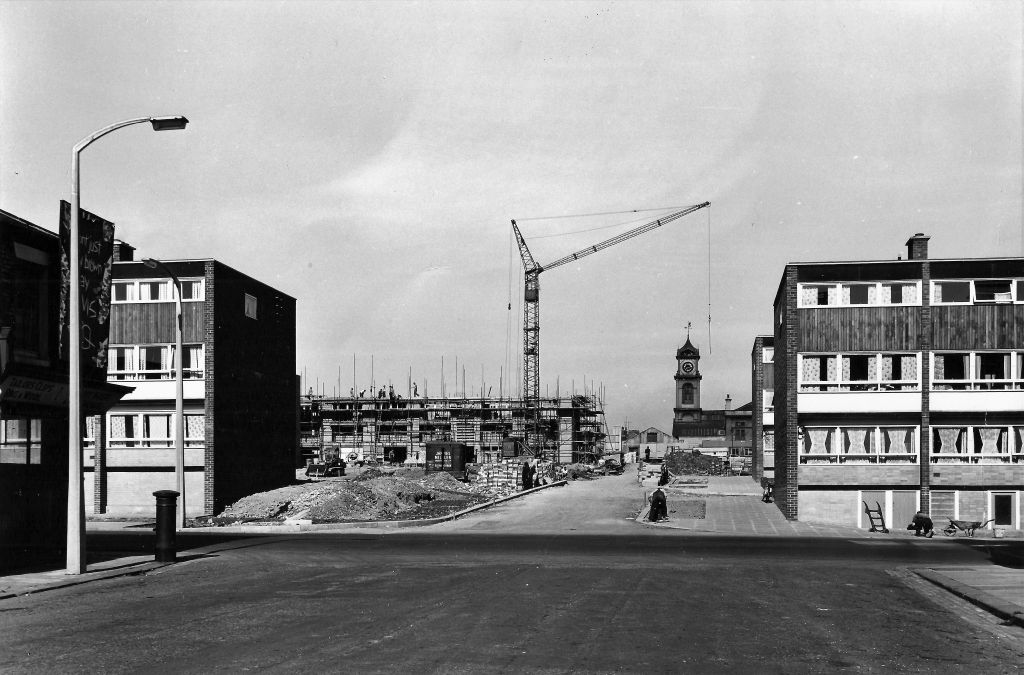Middlesbrough is not an old town. In fact, it has only existed as such since the early 1830s when a grid pattern of streets were laid out and plots sold off to developers who would build houses and commercial premises.
The small township was laid out to support ‘Port Darlington’, an extension of the Stockton & Darlington Railway which now brought coal and other goods by rail all the way to the River Tees near the site now occupied by the Transporter Bridge.
Early Middlesbrough

Middlesbrough farm with gravestones from the priory.
Prior to a town being established, Middlesbrough was an area of agriculture occupied by a farm and a few workers’ cottages.
Before that, there had been a small Benedictine monastery on the site, built in 686AD, with the name ‘Middlesbrough’ itself thought to derive from the site being at the middle point between the two great ecclesiastical houses at Whitby and Durham.
However, by the time the railways and new port came to the area, members of various Quaker families from Darlington purchased the land occupied by the farm in the 1820s. The purchase price was £30,000, for 488 acres, including nearby Monklands Farm too.
The men behind the purchase, led by Joseph Pease, became known as the Owners of the Middlesbrough Estate.
A New Town Laid Out

The investors who purchased the land naturally saw this as a speculative venture which they hoped would nurture their growing coal export business that had been so well enabled by the Stockton & Darlington Railway.
They laid out the site of the new town as a grid pattern of streets, with a central Market Place. Road led into it from Stockton and Stokesley/Guisborough, and those making up the town included:
Commercial Street, Dacre Street, Feversham Street, Gosford Street, Richmond Street, Suffield Street, Cleveland Street, Durham Street, Stockton Street, along with the central North Street, East Street, West Street and South Street.
In all, some 123 plots were planned out, and the first house was built on West Street in 1830.
Other landmarks included the Town Hall at the centre of the Market Square, which was opened in 1846, St Hilda’s Parish Church built in 1840 (with a small cemetery alongside), and the Customs House (built 1835-37), which was invariably used as a town hall, hotel and business exchange in the early years.
Life in St Hilda’s

As Middlesbrough grew thanks to the arrival of heavy industries like mining, shipbuilding, salt production and steel production, this original part of town became known as St Hilda’s.
It was a thriving place of businesses, shops, pubs, hotels, theatres and many, many residences.
In fact, many plots were subdivided to cram in as many dwelling as possible, emanating off tiny, cramped yards with no sanitation and only one or two rooms to house a whole family.
The Transporter Bridge opened in 1911 which put an end to the ferries which would transport workers across the river to Port Clarence and vice versa.
There was also a large Catholic cathedral built in 1876-78 on Sussex Street.
However, as Middlesbrough expanded south and east at a rapid pace, many decided to move with it and the St Hilda’s area became quite dilapidated.
The Parish Church closed and was demolished in 1969, and the current Town Hall had been opened in 1889 to replace the original structure, which later had a string of uses before being abandoned.
Regeneration of St Hilda’s

Redevelopment of old Middlesbrough in the 1960s
Many of the old, original buildings of Middlesbrough were torn down in the 1950s and 60s, and replaced by modern flats and houses.
Most of the businesses, like shops and pubs, had left the area for good, and all that was left was heavier industries occupying new warehouses and factories around the site.
Later, again, many of the 1960s buildings were torn down and replaced in the 1980s. This has recently happened again, with newer flats, houses and even some modern office blocks being constructed in the mid-2000s to the present day.

Middlesbrough’s Old Town Hall in 2025
It’s hard to see anything of the original Middlesbrough township today. Thankfully the Customs House (now MyPlace) and original Town Hall still survive. The latter will soon be redeveloped.
There are some other remnants, like part of a wall of the Ship Inn (Middlesbrough’s oldest public house), and the former Captain Cook pub.
Plans are afoot, however, to continue bringing this historic area back to life. New office blocks, housing, parks and commercial premises are planned. The old Town Hall is also going to be restored and used again.
What are your memories of the original part of Middlesbrough? Did you live there or work there? Leave a comment below!

